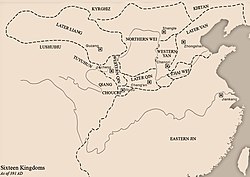Western Qin
This article needs additional citations for verification. (December 2015) |
Western Qin (西秦) 苑川 (387–388) 河南 (388–389, 394, 411–414) 金城 (389–394) 梁 (394–395) 秦 (395–400, 409–411, 414–431) | |||||||||||||
|---|---|---|---|---|---|---|---|---|---|---|---|---|---|
| |||||||||||||
 Western Qin and its neighbors in 391 AD | |||||||||||||
| Status | Vassal of Former Qin, Later Qin, Jin Dynasty (266–420), Northern Wei | ||||||||||||
| Capital | Yongshicheng (385–386) Wanchuan (386–388, 400, 410–412) Jincheng (388–395) Xicheng (395–400) Dujianshan (409–410) Tanjiao (412) Fuhan (412–429) Dinglian (429–430) Nan'an (430–431) | ||||||||||||
| Government | Monarchy | ||||||||||||
| King | |||||||||||||
• 385–388 | Qifu Guoren | ||||||||||||
• 388–400, 409–412 | Qifu Gangui | ||||||||||||
• 412–428 | Qifu Chipan | ||||||||||||
• 428–431 | Qifu Mumo | ||||||||||||
| |||||||||||||
| Today part of | China | ||||||||||||
The Western Qin (Chinese: 西秦; pinyin: Xīqín; 385–400, 409–431) was a state ruled by the Xianbei during the era of Sixteen Kingdoms in China.[1] Note that the Western Qin is entirely distinct from the ancient Qin Dynasty, the Former Qin, and the Later Qin.
All rulers of the Western Qin declared themselves "wang", translatable as either "king" or "prince." They ruled the area that is now southwest part of Gansu province in Northwest China.
Rulers of the Western Qin[]
| Temple name | Posthumous name | Personal name | Durations of reign | Era names |
|---|---|---|---|---|
| Liezu | Xuanlie | Qifu Guoren | 385–388 | Jianyi (建義) 385–388 |
| Gaozu | Wuyuan | Qifu Gangui | 388–400, 409–412 | Taichu (太初) 388–400 Gengshi (更始) 409–412 |
| Taizu | Wenzhao | Qifu Chipan | 412–428 | Yongkang (永康) 412–419 Jianhong (建弘) 420–428 |
| – | – | Qifu Mumo | 428–431 | Yonghong (永弘) 428–431 |
The family tree of Western Qin rulers[]
| Western Qin | |||||||||||||||||||||||||||||||||||||||||||||||||||||||||||||||||||||||||||||||||||||||||||||||||||||||||||||||||||||||||||||||||||||||||||||||||||||||||||||||||||||||||||||||||||||||||||||||||||||||||||||||||||||||
|---|---|---|---|---|---|---|---|---|---|---|---|---|---|---|---|---|---|---|---|---|---|---|---|---|---|---|---|---|---|---|---|---|---|---|---|---|---|---|---|---|---|---|---|---|---|---|---|---|---|---|---|---|---|---|---|---|---|---|---|---|---|---|---|---|---|---|---|---|---|---|---|---|---|---|---|---|---|---|---|---|---|---|---|---|---|---|---|---|---|---|---|---|---|---|---|---|---|---|---|---|---|---|---|---|---|---|---|---|---|---|---|---|---|---|---|---|---|---|---|---|---|---|---|---|---|---|---|---|---|---|---|---|---|---|---|---|---|---|---|---|---|---|---|---|---|---|---|---|---|---|---|---|---|---|---|---|---|---|---|---|---|---|---|---|---|---|---|---|---|---|---|---|---|---|---|---|---|---|---|---|---|---|---|---|---|---|---|---|---|---|---|---|---|---|---|---|---|---|---|---|---|---|---|---|---|---|---|---|---|---|---|---|---|---|---|
| |||||||||||||||||||||||||||||||||||||||||||||||||||||||||||||||||||||||||||||||||||||||||||||||||||||||||||||||||||||||||||||||||||||||||||||||||||||||||||||||||||||||||||||||||||||||||||||||||||||||||||||||||||||||
See also[]
References[]
- ^ Grousset, Rene (1970). The Empire of the Steppes. Rutgers University Press. pp. 59–60. ISBN 0-8135-1304-9.
Categories:
- Western Qin
- 385 establishments
- 400 disestablishments
- States and territories established in the 400s
- 409 establishments
- 431 disestablishments
- Dynasties in Chinese history
- Former countries in Chinese history
- 4th-century establishments in China
- 5th-century establishments in China
- 5th-century disestablishments in China